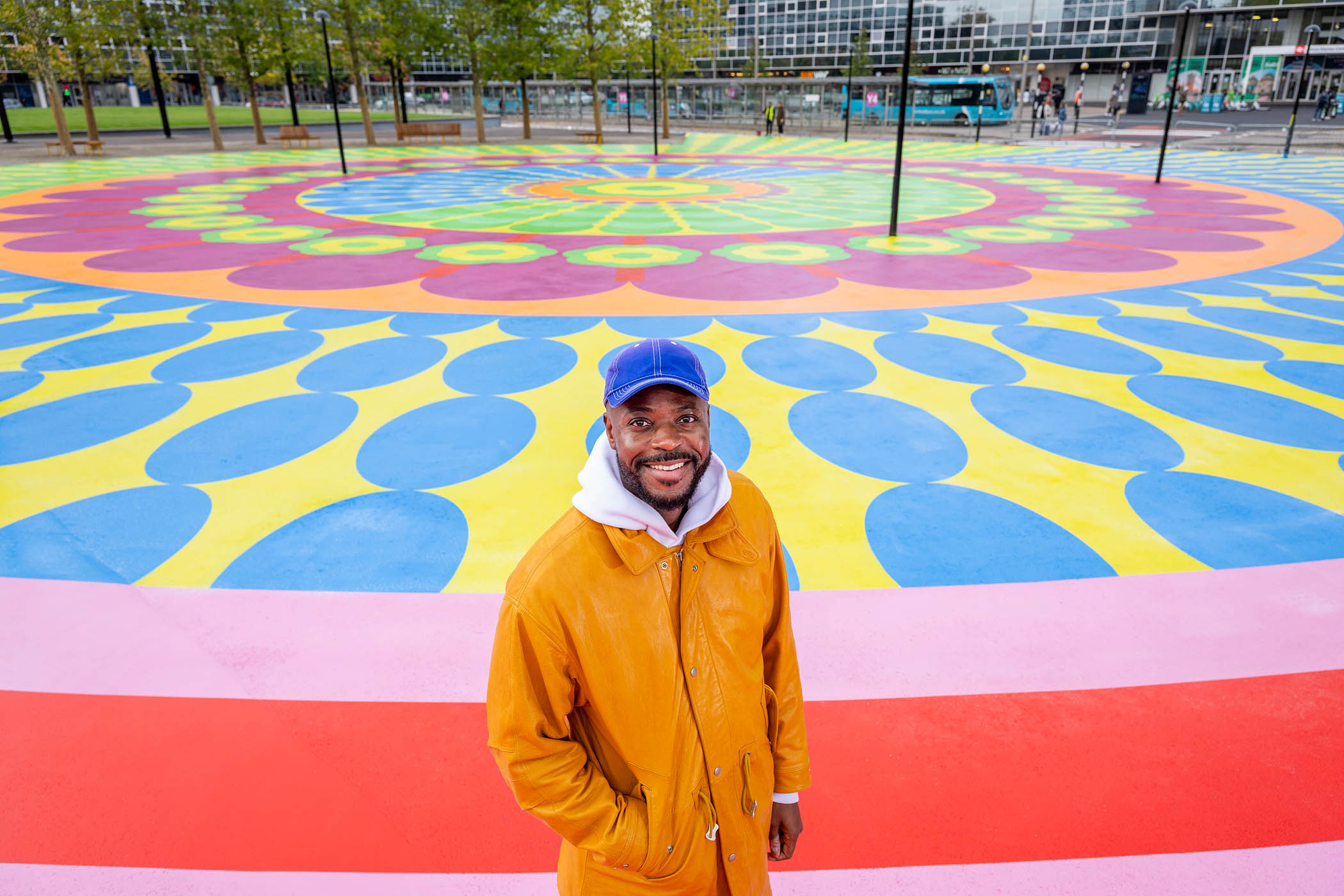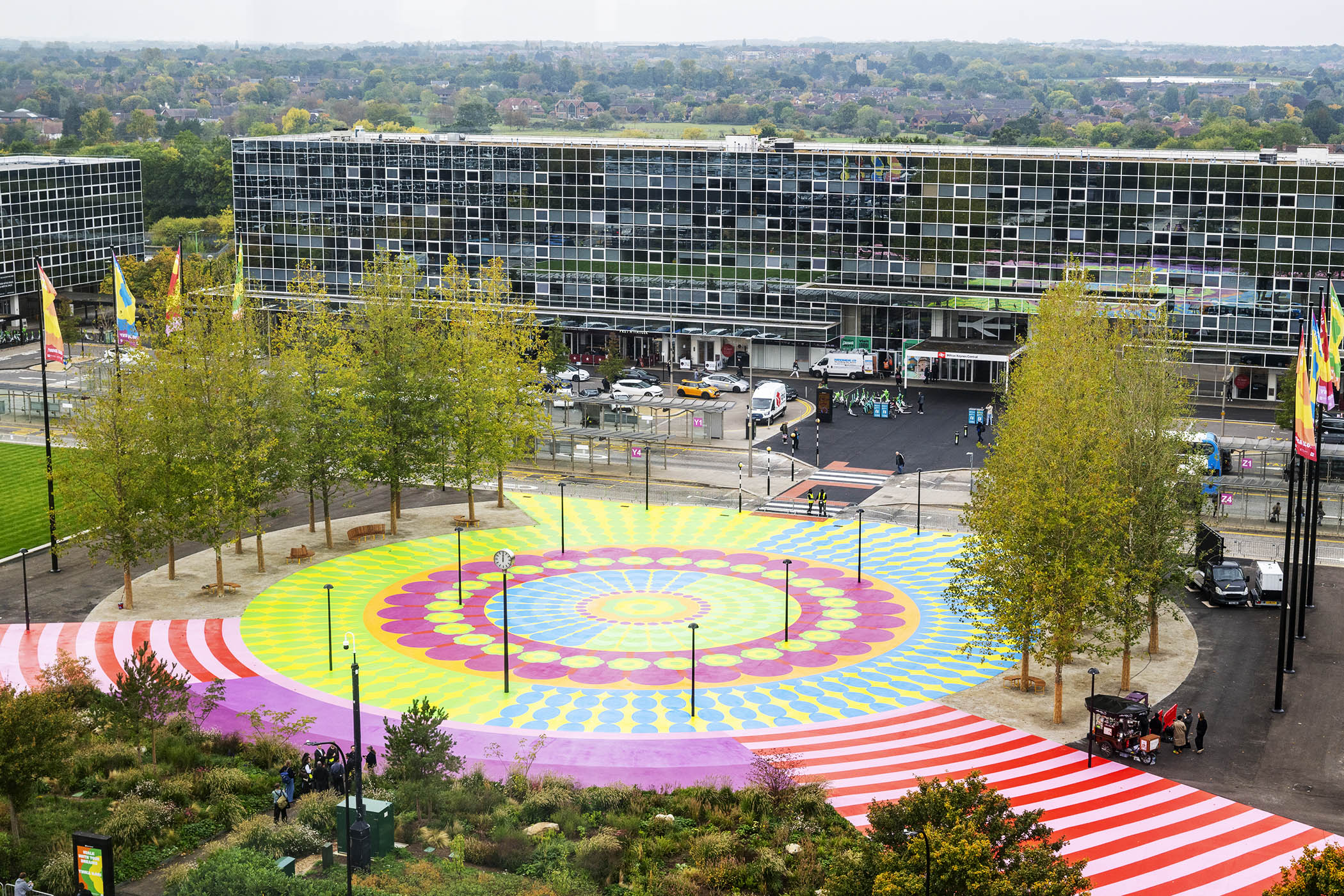There are some men working in bright sunshine as I exit the steel and mirrorglass structure of Milton Keynes train station who are clad, as safety regulations require, in hi-vis. The only things is, their backdrop is such a riot of yellow and green (also mauve, orange and blue) that they’re in effect wearing camouflage.
They’d stand out more if they were wearing grey suits. For the thing on which they are putting the finishing touches is Walk With Your Dreams by the British-Nigerian designer and artist Yinka Ilori, a 3,000 sq metre floor painting itself motivated by a desire for visibility – for the city and the people who live in it. It pushes to the limit the proposition that colour and pattern – paint, in a word – can revitalise a place.
Founded in 1967, Milton Keynes is the last, biggest and most successful of the postwar wave of new towns. It’s growing, with its current population of about 300,000 set to reach more than 400,000 by 2050. People like living there, drawn by its open spaces, relatively affordable homes and handy location between London and Birmingham; it consistently ranks highly in surveys of quality of life. With the government promising to build at least 12 new towns in England, it is the best available template of what to do and what not to do.
According to one account, Milton Keynes was ‘built under a fog of marijuana smoke and Pink Floyd records’
The only thing is, according to the Milton Keynes Development Partnership, it needs to communicate its achievements to the outside world. “It’s very rich in arts and heritage,” I’m told, “but you have to be here to know about it.” So it was crucial to upgrade its main point of entry: the square in front of the railway station – a somewhat arid expanse larger than Trafalgar Square. It had become cluttered, as such places often do, with bins and bike stores. Now it was to be what the development partnership calls “the city’s first sales office” and a harbinger of regeneration to come, including a £75m, 3,500-capacity music venue to be formed out of a disused but listed bus station.
Ilori was appointed, along with the landscape architects Planit, to transform it. His output runs from image-enhancing commissions for big brands – making over Bloomingdale’s in New York, creating cycling gear for the Milanese bike company Cinelli – to low-budget public works such as a playground in Dagenham, east London, or the transformation of a dark underpass in Nine Elms, south London, into the multicoloured Happy Street. All are infused with the same idea, which is to energise an object or a space with a riotous palette drawn from the fabrics of west Africa, with colours that, according to any concept of good taste, should clash and fight, but instead communicate messages of positivity and hopefulness. Ilori talks, over and over, of “dreams”, of “joy”, of “celebrating cultures”.
Milton Keynes is, he says, speaking by Zoom from New York, a city “dear to my heart”, ever since a residency in its arts centre early in his career. In Station Square he wanted to create a space “where everyone is welcome”, that would “allow the community to see themselves in a place”. Milton Keynes is what he calls “a place where you’re able to live together”, a Buckinghamshire melting pot where, according to the 2021 census, 52% of children are from ethnically diverse backgrounds.

Yinka Ilori
And so he brings out the latest iteration of his patterns, on a larger scale than ever before; big concentric circles with smaller circles bubbling within them, rippling out towards the site’s edges. It’s like, he says, “what Nigerians wear when they go to weddings”, and the hope is that it will appeal to everyone, of whatever background.
Ilori and Planit also wanted to announce one of Milton Keynes’s assets, which is its abundance of greenery. Travellers arriving in the hard old version of the square did not get much sense of this. Now there are 22 plane trees, 40 years old, 18-metre-high, imported from the Netherlands, which curve around the sides of Ilori’s colourful circle, whose patterns are derived from flowers. On the far side of the square from the station, concealing the concrete embankment to an elevated road, are deep beds of planting, dense but loose and naturalistic, varied in scale and type, with plenty of colour, especially in summer. It’s biodiverse, with what James King, a director at Planit, calls “loads of pollinators”.
If Walk With Your Dreams, which was unveiled last week, seems to diverge from the cool, gridded modernism that is the dominant style of central Milton Keynes, it taps into a psychedelic hippiedom that was an equal and opposite aspect of the city’s making. According to one account, Milton Keynes was “built under a fog of marijuana smoke and Pink Floyd records”, with pyramids, mounds and circles inspired by prehistoric earthworks, its central avenue – Midsummer Boulevard – aligned like Stonehenge with the summer solstice sunrise. Ilori’s circle, which marks the start of the boulevard, connects with this druidical geometry.
It’s hi-vis for MK – a new image for a city whose most famous previous artwork was concrete cows. The square will be a place for lingering and gathering; also for commuters striding to and from their trains. One of the design’s functions is to guide people to a pair of underpasses that lead to the rest of the city centre. There will be screenings and events in the square, which in its unreformed state served as a fan zone for several games of the Women’s Euro 2022 that were held in the city.
It’s a simple enough concept, and one that might have ended up tokenistic and flimsy, but Ilori brings it off. It works through scale and dazzle, the bravura with which he can combine almost any colour with almost any other. Its appeal is direct. “I can’t wait to bring my kids here” says one of the men who made it, whose usual job is painting oil rigs.
Photographs by Andy Stagg, Stephen Chung

